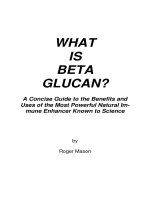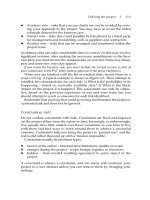A clinical guide to stem cell and bone marrow transplantation - part 1 pps
Bạn đang xem bản rút gọn của tài liệu. Xem và tải ngay bản đầy đủ của tài liệu tại đây (1.13 MB, 55 trang )
Page x
Psychosexual adjustment following BMT
413
Long-term post-transplant testing and evaluation
415
Immunizations
416
Chapter 10
Psychosocial Issues
Daniel Shapiro, Cynthia Monheim
419
Evidence of major depression
419
Mania
420
Substance abuse
420
Psychosis or delusions
420
Overwhelming anxiety
421
Suicidal ideation in the absence of hopeless medical circumstances
421
StafF-patient conflicts
422
Pain medication abuse
425
Interventions helpful for all patients
426
Interventions helpful for family
429
Interventions helpful for donors
429
Pretransplant screenings
430
''Difficult patients"
431
Emotionally difficult circumstances
434
Index
440
Page ii
The Jones and Bartlett Series in Oncology
Blood and Marrow Stem Cell Transplantation, Second Edition, Whedon/Wujcik
Cancer Chemotherapy: A Nursing Process Approach, Second Edition, Barton Burke et al.
Cancer Nursing: Principles and Practice, Fourth Edition, Groenwald et al.
Cancer Symptom Management, Groenwald et al.
Cancer Symptom Management Patient Self-Care Guides, Groenwald et al.
A Cancer Source Book for Nurses, Seventh Edition, American Cancer Society
Homecare Management of the Bone Marrow Transplant Patient, Second Edition, Lonergan et al.
Hospice and Palliative Care: Concepts and Practice, Sheehan/Forman
Oncology Nursing Drug Reference, Second Edition, Wilkes et al.
Memory Bank for Chemotherapy, Third Edition, Preston/Wilfinger
Page iii
A Clinical Guide to Stem Cell and Bone Marrow
Transplantation
Terry Wikle Shapiro RN-C, MSN, CFNP
University of Arizona Adult and Pediatric Bone Marrow
Transplantation Program, Tucson, AZ
Deborah Branney Davison RP-C, MSN, CRNP
Western Pennsylvania Cancer Institute, Pittsburgh, PA
Deborah M. Rust RN, MSN, CRNP, OCN
University of Pittsburgh School of Nursing, Oncology Subspecialty,
Nurse Practitioner Program, Pittsburgh, PA
25791-0iiia.GIF
JONES AND BARTLETT PUBLISHERS
Sudbury, Massachusetts
Boston Toronto London Singapore
Page iv
World Headquarters
Jones and Bartlett Publishers
40 Tall Pine Drive
Subdury, MA 01776
978-443-5000
800-832-0034
www.jbpub.com
Jones and Bartlett Publishers Canada
P.O. Box 19020
Toronto, ON M5S 1X1
CANADA
Jones and Bartlett Publishers International
Barb House, Barb Mews
London W6 7PA
UK
Acquisitions Editor: Robin Carter
Production Editor: Nindy LeRoy
Manufacturing Buyer: Jenna Sturgis
Design: Kenneth Hollman Editorial Production Service: Ellipsis Inc.
Illustration: Horizon Design
Typesetting: Ellipsis Inc.
Cover Design: Hannus Design Associates
Printing and Binding: Courier
Cover Printing: John Pow Company
Copyright © 1997 by Jones and Bartlett Publisher, Inc.
All rights reserved. No part of the material protected by this copyright notice may be reproduced or
utilized in any form, electronic or mechanical, including photocopying, recording, or by any
information storage and retrieval system, without written permission from the copyright owner.
Library of Congress Cataloging-in-Publication Data
Shapiro, Terry Wikle.
A clinical guide to stem cell and bone marrow transplantation /
Terry Wikle Shapiro, Deborah Branney Davison, Deborah M. Rust.
p. cm.
Includes bibliographical references and index.
ISBN 0-7637-0217-X (alk. paper)
1. Bone marrow—Transplantation—Handbooks, manuals, etc.
2. Hematopoietic stem cells—Transplantation—Handbooks, manuals, etc.
I. Davison, Deborah Branney. II. Rust, Deborah M. III. Title.
[DNLM: 1. Stem Cells—transplantation—handbooks. 2. Bone Marrow
Transplantation—handbooks. 3. Tissue Transplantation—nursing—handbooks.
QH 581.2 5529c 1997]
RD123.5.S535 1997
617.4'4—dc21
DNLM/DLC
for Library of Congress 97-9563
Printed in the United States of America
01 00 99 98 10 9 8 7 6 5 4 3 2
Page v
Disclaimer
The nature of clinical bone marrow transplantation information is that it is constantly evolving
because of ongoing research and clinical experience and is often subject to interpretation. While
great care has been taken to ensure the accuracy of the information presented, the reader is advised
that the authors, editors, reviewers, contributors, and publishers cannot be responsible for the
continued currency of the information, for any errors or omissions in this handbook, or for any
consequences arising therefrom. Because of the dynamic nature of clinical bone marrow
transplantation, readers are advised that decisions regarding therapy must be based on the
independent judgment of the clinician, changing information about a drug (e.g., as reflected in the
literature and manufacturer's most current product information), and hanging medical practices.
Contributors
Deborah Branney Davidson, MSN, RP-C, CRNP
Coordinator, Western Pennsylvania Cancer Institute
Cynthia Monheim, BA
Graduate Student, Department of Clinical Psychology, University of Arizona
Deborah M. Rust, RN, MSN, CRNP, OCN
Program Manager, Oncology Nurse Practitioner Program, University of Pittsburgh School of
Nursing
Nurse Practitioner, Adult Bone Marrow Transplant Program, University of Pittsburgh Cancer
Institute
Daniel E. Shapiro, PhD, Assistant Professor, Department of Psychiatry, College of Medicine,
University of Arizona
Terry Wikle Shapiro, RN-C, MSN, CFNP
Pediatric and Adult Nurse Practitioner, Bone Marrow Transplant Program, University Medical
Center, University of Arizona
Dedication
To Patricia Schaefer, RN, MD, who gave us the push
we needed to see this project become a reality. We also
cannot thank our families enough—our husbands
Daniel, Dan, and Keith, and our children Alexandra,
Derek, and Leah, who lent support and sanity in our
times of need . . . we love you!
Page vi
Preface
As the science and technology of clinical stem cell and bone marrow transplantation has grown, so
has the need for a comprehensive guide to caring for these complex patients. As the number of
advanced practice nurses, specialty nurses, physician's assistants, fellows, residents, and medical
students who care for such patients grows, so does the need for relevant and practical information.
We decided to put our combined 30-plus years of stem cell and bone marrow transplant experience
to good use, and thus, this handbook was developed. The concept of this handbook also arose as a
result of multiple pleas for a comprehensive "nuts and bolts" guide from colleagues intimately
involved in the day-to-day management of patients undergoing stem cell and bone marrow
transplantation.
In summary, we have attempted to provide the clinician with a pocket guide to assist in quick-
referencing clinical issues and problems common to stem cell and bone marrow transplantation. In
our experience, no single clinical handbook currently provides the bone marrow transplantation
clinician with comprehensive information relevant to stem cell and bone marrow transplantation.
Although we doubt this will be "the only handbook you'll ever need," we do think it will save the
bone marrow transplantation clinician time and frustration when looking up clinical information
specific to bone marrow transplantation.
The user should keep in mind that the content included in this text is general information
extrapolated from the literature, and that program and institutional differences are bound to occur.
In addition, stem cell and bone marrow transplantation technology changes at a rapid pace. Clearly,
discoveries will be made before this text is published that will alter the accuracy of the information
in this handbook. Nevertheless, it is our hope that this handbook will assist clinicians who provide
day-to-day management to these challenging patients, providing an easier way to obtain the critical
information they need to care for their patients.
TERRY WIKLE SHAPIRO, RN-C, MSN, CFNP
Page vii
Contents
Introduction to Stem Cell and Bone Marrow Transplantation
Terry Wikle Shapiro
1
Allografting
1
Autografting
3
When should marrow or blood cell transplantation be considered?
5
Chapter 1
Pretransplant Evaluation
Deborah Branney Davison
29
Patient evaluation
29
Donor identification/HLA system
31
Inheritance of HLA type
32
HLA typing
33
Donor evaluation
35
Chapter 2
Conditioning Regimens and Management of Common Toxicities
Deborah M. Rust
39
Combination chemotherapy conditioning and immunosuppressive
regimens
39
Management of conditioning regimen-related toxicities
46
Chapter 3
Prophylactic Regimens
Terry Wikle Shapiro
81
Infection in stem cell and bone marrow transplant patients
81
Antimicrobial prophylaxis
85
Graft-versus-host disease prophylaxis
98
Veno-occlusive disease prophylaxis
107
Page viii
Chapter 4
Bone Marrow, Peripheral Blood Stem Cell, and Umbilical Cord Blood
Procurement and Infusion
Deborah Branney Davison
113
Allogeneic bone marrow harvest
113
Autologous bone marrow harvest
115
Complications of bone marrow harvesting
116
Bone marrow processing
116
Mobilization and collection of peripheral blood stem cells
118
Umbilical cord blood collection
120
Infusion of marrow-stem cells
121
Chapter 5
Management of Stem Cell/Bone Marrow Transplantation Complications
Terry Wikle Shapiro, Deborah M. Rust, Deborah Branney Davison
125
Hematopoietic complications
126
Infectious complications
137
Graft-versus-host disease (GVHD)
185
Pulmonary complications
197
Cardiac complications
206
Gastrointestinal complications
214
Renal and hepatic complications
223
Neurologic complications
231
Chapter 6
Diagnostic Test Interpretations
Deborah M. Rust
255
Hematology
255
Blood component replacement
257
Blood chemistries, electrolytes, and minerals
259
Page ix
Body fluids
263
Microbiology
268
Liver functions and gastroenterology
270
Cytogenetics
274
Endocrinology
276
Radiology
280
Immunology
284
Chapter 7
Formulary
Terry Wikle Shapiro, Deborah Branney Davison
291
Drugs common to bone marrow and stem cell transplants
291
Special drug monitoring
369
Antiemetic management
371
Pain and sedation
373
Antimicrobial selection
375
Drugs in renal failure
377
Chapter 8
Therapeutic Data
Deborah M. Rust, Terry Wikle Shapiro
381
Transfusion therapy
381
Blood and blood products
383
Transfusion reactions
386
Nutrition support
387
Growth charts and pediatric calculations and values
396
Chapter 9
Long-Term Follow-Up
Deborah Branney Davison
411
Ambulatory management following bone marrow transplant (BMT)
411
Page i
A Clinical Guide to Stem Cell and Bone Marrow
Transplantation
Page 1
Introduction to Stem Cell and Bone Marrow Transplantation
The pluripotent stem cells from which all committed blood cells arise (Figure I.1) are located in the
bone marrow space, the peripheral blood, and the blood in the umbilical cord of newborns. All of
these sites can be used as a source of bone marrow stem cells, whether for autologous or allogeneic
marrow transplantation.
Figure I.1
Depicts hematopoiesis.
I. Allografting
A. Allografting involves transplanting marrow, peripheral blood stem cells (PBSCs), or umbilical
cord blood (UCB) to a recipient who is genetically different.
Page 2
B. Allografting using a monozygotic twin as a donor is termed a syngeneic transplant.
C. The most common and preferred situation is for marrow to be donated by a six out of six-
antigen, human leukocyte antigen (HLA)-matched, (HLA-identical) sibling.
D. Partially matched family members or matched unrelated donors from a volunteer panel may also
be used as donors.
E. UCB may be used as a source of allogeneic stem cells in the matched sibling donor as well as in
the unrelated donor.
F. Allograft sources of marrow/blood cells
1. Matched sibling donor
a) Marrow
b) PBSCs
c) UCB
2. Identical twin donor
a) Marrow
b) PBSCs
c) UCB
3. Partially-matched related donor
a) Marrow
b) PBSCs
c) UCB
4. Matched unrelated donor
a) Marrow
b) UCB
5. Partially-matched unrelated donor
a) Marrow
b) UCB
G. Allografts are indicated for some congenital abnormalities of bone marrow function or where
there is disease involving the marrow not amenable to cure with standard treatment.
Page 3
1. Leukemias
a) Acute myelogenous leukemia (AML)
b) Acute lymphoblastic leukemia (ALL)
c) Chronic myelogenous leukemia (CML)
d) Myelodysplastic syndromes (MDS)
e) Acute myelofibrosis
2. Lymphoproliferative disorders
a) Hodgkin's disease
b) Non-Hodgkin's lymphoma
c) Multiple myeloma
d) Chronic lymphocytic leukemia
3. Hematologic disorders
a) b-Thalassemia
b) Sickle cell anemia (SCA)
c) Congenital neutropenias
d) Osteopetrosis
4. Bone marrow failure syndromes
a) Severe aplastic anemia (SAA)
b) Fanconi's anemia (FA)
c) Reticular dysgenesis
5. Immunodeficiencies
a) Severe combined immunodeficiencies
b) Wiskott-Aldrich syndrome
c) Miscellaneous immunodeficiencies
6. Nonhematologic genetic disorders
a) Mucopolysaccharidosis
b) Leukodystrophies
c) Miscellaneous metabolic disorders
II. Autografting
A. Autografting involves transplanting marrow or PBSCs back into the person from whom the
blood cells originated.
Page 4
B. Since a marrow or stem cell source for allografting cannot always be found or may be too risky,
autologous bone marrow or PBSC transplantation is also used as a method for treating a number of
malignant disorders.
1. Leukemias
a) AML
b) ALL
c) CML
2. Lymphoproliferative disorders
a) Hodgkin's disease
b) Non-Hodgkin's lymphoma
c) Multiple myeloma
d) Chronic lymphocytic leukemia
3. Solid tumors
a) Neuroblastoma
b) Ewing's sarcoma
c) Breast cancer
d) Testicular cancer
e) Melanoma
f) Osteosarcoma
g) Cerebral tumors
h) Others
C. Using autologous marrow or PBSCs is not feasible for patients who have a deficiency of their
functional bone marrow, as with aplastic anemia, inborn errors of metabolism, and
immunodeficiency states.
1
D. In certain circumstances, using autologous marrow or PBSCs may be preferable to using an
allogeneic source of stem cells, for example, to avoid graft-versus-host disease (GVHD) in
situations when marrow contamination with malignant cells is likely, and there is no evidence of an
immunologic antitumor effect ("graft versus leukemia" or something similar) with allogeneic
transplant.
Page 5
E. In older patients (> 50 years of age), autografting may also be considered more desirable because
of the high morbidity and mortality associated with allografting and GVHD.
F. Autografting is most frequently used in the setting of high-risk solid tumors in which the chance
for cure is relatively low with standard or conventional doses of chemotherapy. In this case,
autografting is considered a marrow or stem cell "rescue."
G. In some autografting situations, it is questioned whether a low (undetectable) level of tumor
cells persisting in the infused cells may promote relapse. However, routine purging, even in
diseases that involve the marrow, is unproved. Research in this area continues.
H. PBSCs are used as an autografting source in cases of prior pelvic irradiation, marrow fibrosis,
unacceptable anesthesia risk, or when early engraftment is desired.
2
III. When Should Marrow or Blood Cell Transplantation be Considered?
A. Acute myelogenous leukemia (AML)
1,
3
1. The classification of AML can be divided into seven main categories based on
morphology and cytochemistry as proposed by the French American and British (FAB)
group
4
(Table I.1). Some of these subtypes, such as M5, are associated with poor outcomes
after chemotherapy alone. Other subtypes, such as M3, are associated with more favorable
outcomes. Overall, the FAB classification has not been found to be significantly useful as a
predictive factor for outcome after chemotherapy alone.









